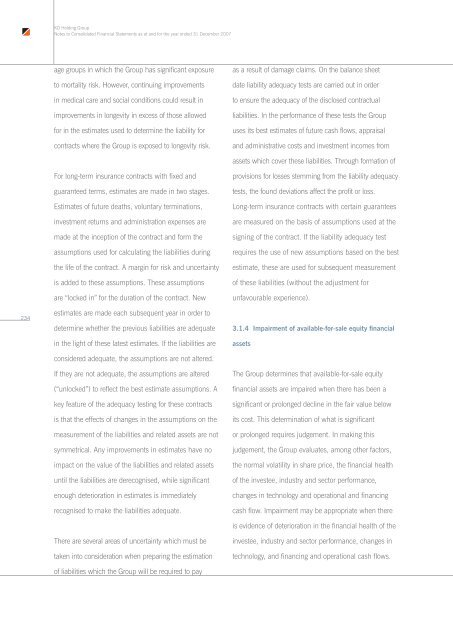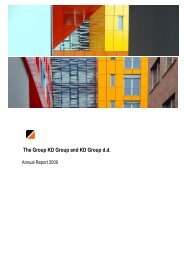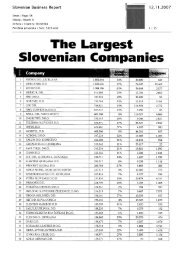We build business networks and relationships ... - skupina kd group
We build business networks and relationships ... - skupina kd group
We build business networks and relationships ... - skupina kd group
Create successful ePaper yourself
Turn your PDF publications into a flip-book with our unique Google optimized e-Paper software.
KD Holding Group<br />
Notes to Consolidated Financial Statements as at <strong>and</strong> for the year ended 31 December 2007<br />
age <strong>group</strong>s in which the Group has significant exposure<br />
to mortality risk. However, continuing improvements<br />
in medical care <strong>and</strong> social conditions could result in<br />
improvements in longevity in excess of those allowed<br />
for in the estimates used to determine the liability for<br />
contracts where the Group is exposed to longevity risk.<br />
as a result of damage claims. On the balance sheet<br />
date liability adequacy tests are carried out in order<br />
to ensure the adequacy of the disclosed contractual<br />
liabilities. In the performance of these tests the Group<br />
uses its best estimates of future cash flows, appraisal<br />
<strong>and</strong> administrative costs <strong>and</strong> investment incomes from<br />
assets which cover these liabilities. Through formation of<br />
234<br />
For long-term insurance contracts with fixed <strong>and</strong><br />
guaranteed terms, estimates are made in two stages.<br />
Estimates of future deaths, voluntary terminations,<br />
investment returns <strong>and</strong> administration expenses are<br />
made at the inception of the contract <strong>and</strong> form the<br />
assumptions used for calculating the liabilities during<br />
the life of the contract. A margin for risk <strong>and</strong> uncertainty<br />
is added to these assumptions. These assumptions<br />
are “locked in” for the duration of the contract. New<br />
estimates are made each subsequent year in order to<br />
determine whether the previous liabilities are adequate<br />
in the light of these latest estimates. If the liabilities are<br />
considered adequate, the assumptions are not altered.<br />
If they are not adequate, the assumptions are altered<br />
(“unlocked”) to reflect the best estimate assumptions. A<br />
key feature of the adequacy testing for these contracts<br />
is that the effects of changes in the assumptions on the<br />
measurement of the liabilities <strong>and</strong> related assets are not<br />
symmetrical. Any improvements in estimates have no<br />
impact on the value of the liabilities <strong>and</strong> related assets<br />
until the liabilities are derecognised, while significant<br />
enough deterioration in estimates is immediately<br />
recognised to make the liabilities adequate.<br />
There are several areas of uncertainty which must be<br />
taken into consideration when preparing the estimation<br />
of liabilities which the Group will be required to pay<br />
provisions for losses stemming from the liability adequacy<br />
tests, the found deviations affect the profit or loss.<br />
Long-term insurance contracts with certain guarantees<br />
are measured on the basis of assumptions used at the<br />
signing of the contract. If the liability adequacy test<br />
requires the use of new assumptions based on the best<br />
estimate, these are used for subsequent measurement<br />
of these liabilities (without the adjustment for<br />
unfavourable experience).<br />
3.1.4 Impairment of available-for-sale equity financial<br />
assets<br />
The Group determines that available-for-sale equity<br />
financial assets are impaired when there has been a<br />
significant or prolonged decline in the fair value below<br />
its cost. This determination of what is significant<br />
or prolonged requires judgement. In making this<br />
judgement, the Group evaluates, among other factors,<br />
the normal volatility in share price, the financial health<br />
of the investee, industry <strong>and</strong> sector performance,<br />
changes in technology <strong>and</strong> operational <strong>and</strong> financing<br />
cash flow. Impairment may be appropriate when there<br />
is evidence of deterioration in the financial health of the<br />
investee, industry <strong>and</strong> sector performance, changes in<br />
technology, <strong>and</strong> financing <strong>and</strong> operational cash flows.







